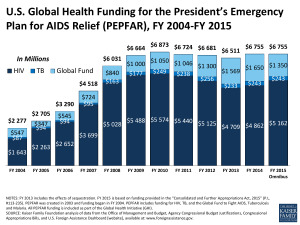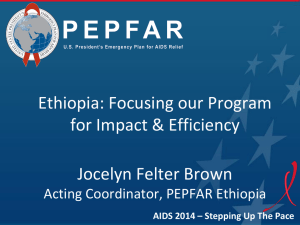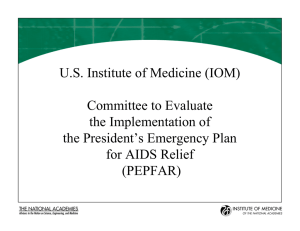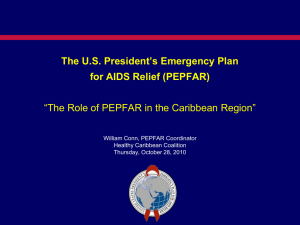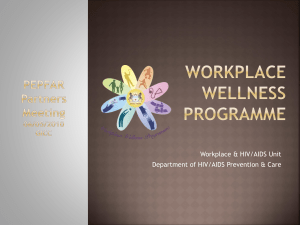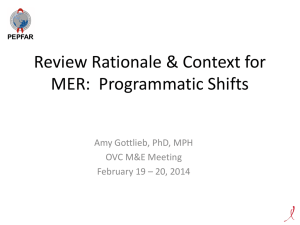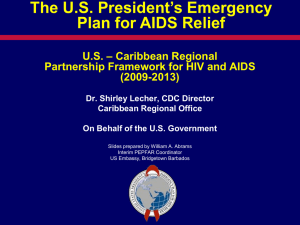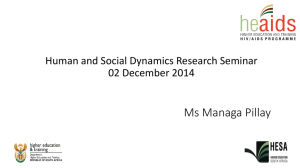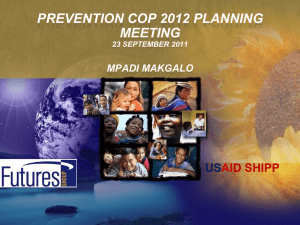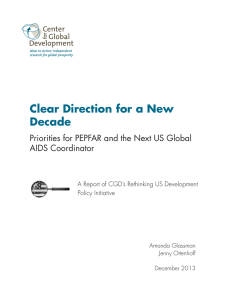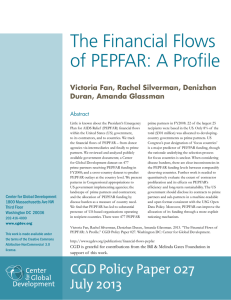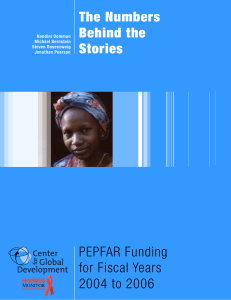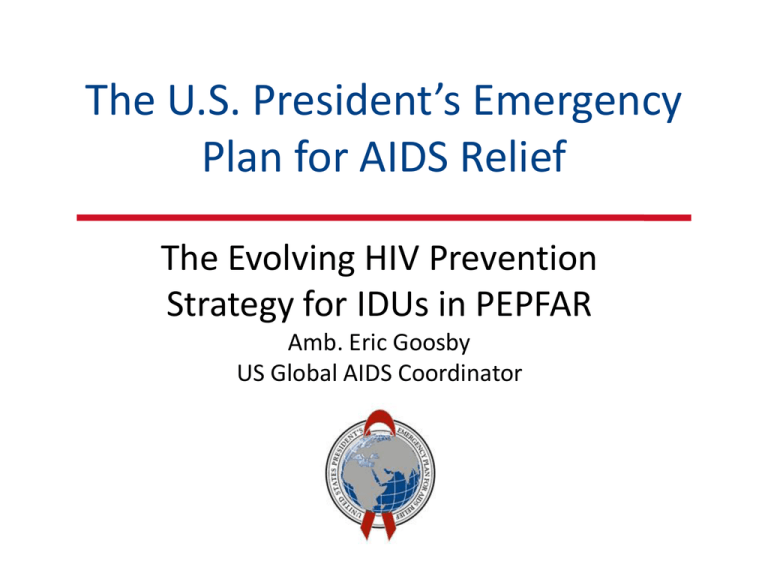
The U.S. President’s Emergency
Plan for AIDS Relief
The Evolving HIV Prevention
Strategy for IDUs in PEPFAR
Amb. Eric Goosby
US Global AIDS Coordinator
Topical Outline
•
•
•
•
PEPFAR Background
Burden of HIV Disease among IDUs
Service Coverage for IDU
PEPFAR Plans to Increase Access, Expand Coverage
and Reduce Disease Burden
• Challenges Ahead
PEPFAR: The US Response to the Global AIDS Crisis
• 2003: PEPFAR launched
• 2008: PEPFAR reauthorized through
2013
• US accounts for 58% of all global
AIDS investments (USD $32 billion
through FY2010)
• Interagency coordination model
• PEPFAR as cornerstone of US Global
Health Initiative
PEPFAR 2009-2013
• Builds on first phase
• Emphasis on supporting country ownership for
sustainability
• Continue to support countries with both generalized and
concentrated epidemics to scale up treatment (more than 4
million), prevention (more than 12 million) and care (more
than 12 million)
• Includes focus on HIV prevention, treatment and care
in countries with concentrated epidemics of HIV
• Person who inject drugs
• MSM
• Female sex workers
IDUs in Countries with PEPFAR Programs
• 5.3m IDUs living
in countries with
PEPFAR programs
• Concentrated in
Russia, Ukraine
Central Asia, and
China
Gender Distribution of Injection Drug Use
IDUs Living with HIV in Countries with PEPFAR Programs
• Estimated 800k HIVpositive IDUs in
countries with
PEPFAR programs
• Injection drug use is
leading driver of
HIV/AIDS in Asia and
Eastern Europe
HIV Cases Attributable to Injection Drug Use
100.0%
90.0%
80.0%
70.0%
60.0%
50.0%
40.0%
30.0%
20.0%
10.0%
0.0%
72.5%
60.3%
70.0%
60.0%
72.0%
55.2%
51.7%
38.5%
Russia
Ukraine
Georgia
Kazakhstan Kygyzgstan Tajikistan
Vietnam
China
42.2%
Indonesia
*Cambodia, Tanzania, Kenya, and South Africa do not have data available.
Still, there are ~4.5m million IDUs who are HIV-negative
in countries with PEPFAR programs
Coverage of Core Interventions in Countries with
PEPFAR Programs
Low
Coverage
Medium
Coverage
High
Coverage
Current
Coverage
NSP
<20%
20-60%
>60%
10%
533k/5.3m
MAT
<20%
20-40%
>40%
4%
104k/3.2m
ART for IDU
<25%
25-75%
>75%
?
Access to core interventions is believed to be
extremely low in countries with significant IDU
populations and PEPFAR programs
NSP Coverage in Countries with PEPFAR Programs
• Needle & Syringe Access
Programs (NSPs)
• Of 5.3m IDUs in PEPFAR
countries, only 533k (10%)
receive NSP assistance from
any source.
• Those who do access 44m
needles, or just over 80
needles per injector, per
year.
MAT Coverage in Countries with PEPFAR Programs
• Of 3.2m opioid injectors
in these countries, only
104k (~4%) are on MAT.
• Tajikistan and Cambodia
recently began MAT.
• Tanzania is starting in
July 2010.
Alignment of U.S Drug, Domestic HIV/AIDS and
PEPFAR Prevention Strategies
• Coordination between PEPFAR and the White House
Offices of National Drug Control Policy and National
AIDS Policy
• Obama Administration’s National Drug Control
Strategy: comprehensive approach based on a
balanced public health and public safety model
• Main goals:
• (1) curtail illicit drug use and
• (2) reduce the consequences of drug use, including those
imposed by HIV/AIDS
PEPFAR’s Prevention Goals
• Goal : Support the prevention of more than 12 million
new HIV infections
• “Evidence-based combination HIV prevention”
• Structural/policy changes to create supportive enabling
environments
• Biomedical
• Behavioral
PEPFAR’s Evolving Prevention Strategy for IDUs
PEPFAR:
• Provides a comprehensive package of evidence-based
interventions
• Creates enabling environments and a human rightsbased approach to prevention for IDUs
• Secures commodities to reduce the risk of HIV
transmission
• Coordinates an efficient international response
• Links to international indicators
Evidence-Based Interventions
Evidence-based Comprehensive Package of Interventions
(WHO, UNODC, UNAIDS, 2009)
1. Needle and syringe programs (NSPs)
2. Medication-Assisted Treatment (MAT) and
other drug dependence treatment
3. Antiretroviral therapy (ART)
4. HIV testing and counseling (T & C)
5. Prevention and treatment of sexually
transmitted infections (STIs)
6. Condom programs for IDUs and their sexual
partners
7. Targeted information, education and
communication (IEC) for IDUs and their
sexual partners
8. Vaccination, diagnosis and treatment of
viral hepatitis
9. Prevention, diagnosis and treatment of
tuberculosis (TB).
Access to Services & Protection of Human Rights
• PEPFAR programs should seek to create safe spaces
for IDUs to access services and ensure that services
are based on:
•
•
•
•
•
•
Equity
Nondiscrimination
Voluntariness
Collaboration and involvement of affected populations
Combat stigma or discrimination
Do not increase risk for violence or incarceration
Optimizing Global HIV Prevention Impact
• PEPFAR will:
• Formalize, strengthen and coordinate our responses with
key multilateral and bilateral organizations
• With multilateral and bilateral partners:
• Provide critical in-country technical support
• Bring significant resources for prevention
• Build political will to bring civil society into the process.
• Improving health outcomes for IDUs is a shared
responsibility
Challenges Ahead
• Rapid scale-up of services
• Increase capacity of health care systems
• Ensure that programs are:
•
•
•
•
•
•
•
Available
Accessible
High-quality
Sustainable
Achieving high coverage
Monitored and evaluated
Impacting the epidemic
Conclusions
There is a mismatch between the current burden of
disease among IDUs and coverage rates.
• PEPFAR is working with partner governments and civil
society to address this imbalance
• PEPFAR guidance supports country-driven
interventions that are evidence- and human rightsbased and reach populations who are most at risk
• PEPFAR seeks to ensure that country-owned and -led
programs and interventions are developed and
implemented with respect for human rights of IDUs
Thank you
For further information, please visit:
www.PEPFAR.gov
http://twitter.com/uspepfar
www.facebook.com/PEPFAR

